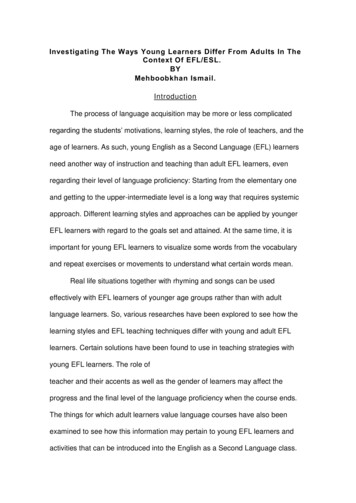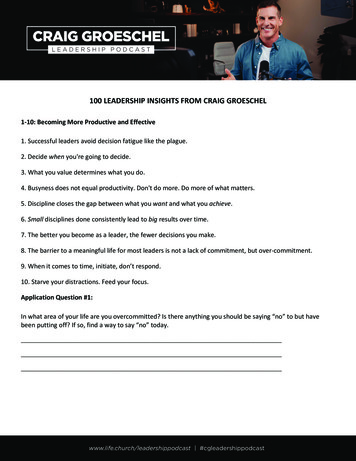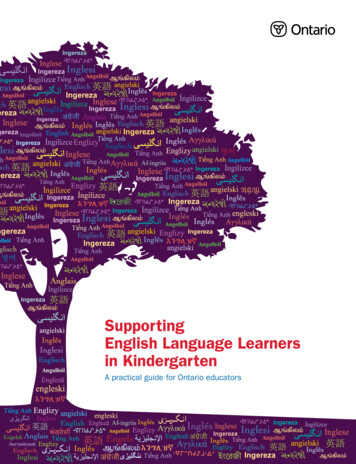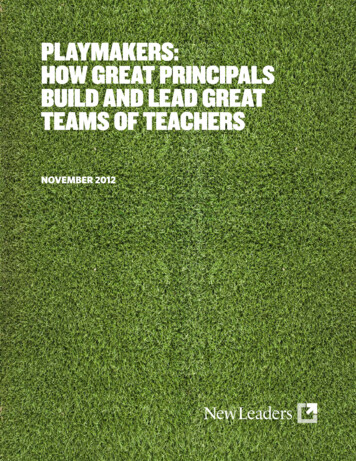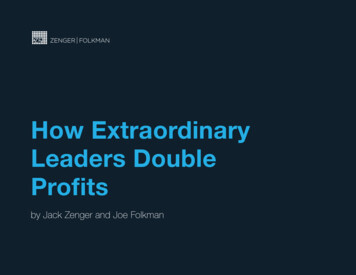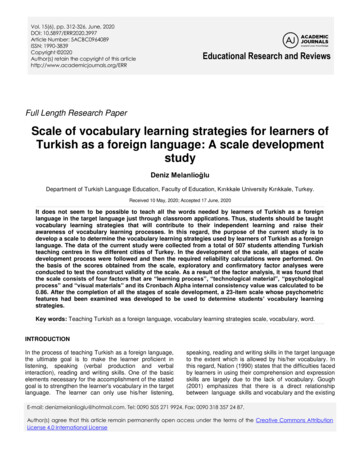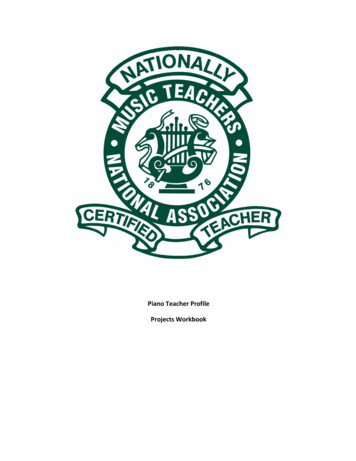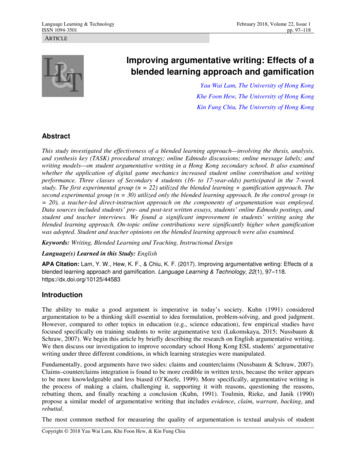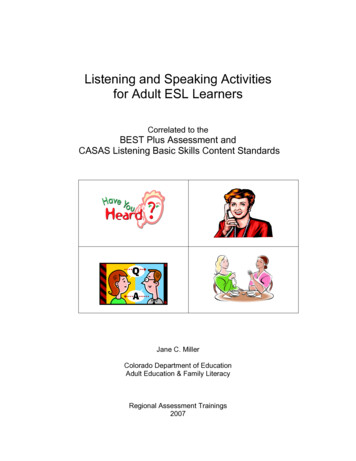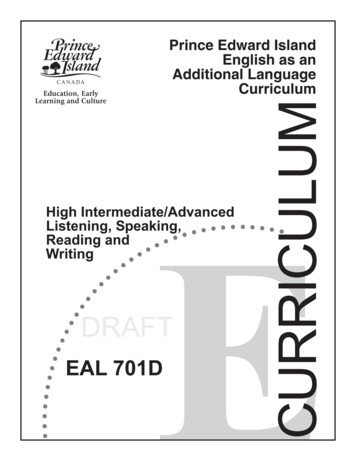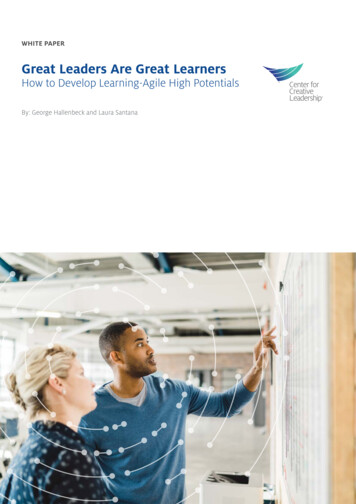
Transcription
WHITE PAPERGreat Leaders Are Great LearnersHow to Develop Learning-Agile High PotentialsBy: George Hallenbeck and Laura Santana
ContentsExecutive Summary1What’s Learning Agility?2Who is Learning Agile? How to Identify It In Your Talent4The Difference Between High Professionals and High Potentials5How to Develop Learning Agility8Getting the Right Experience10Conclusion: Where Do We Go From Here?12About the Authors13
Executive SummaryWhile learning agility has become a hot topic in recent decades, there’s not yet widespreadunderstanding of its underlying nature, nor the best way for organizations and talentdevelopment leaders to leverage it, especially because it isn’t a skill that’s necessarilyconcentrated at the top of your organization. Instead, it’s likely dispersed among leadersat all levels. And it’s often overlooked. By learning how to identify and cultivate learningagility, your organization can create more confident leaders who are ready for the future,who are able to proactively identify business opportunities, and who can quickly respond tounexpected challenges.This white paper offers CCL’s perspective on 3 of the most fundamental and frequentquestions about learning agility: What is learning agility, and who possesses it? How do I identify learning agility in my organization’s leaders? How do I develop learning agility in myself and my organization’s leaders?Importantly, we’ll outline the difference between high potentials and high professionals, 2classes of highly coveted employees that organizations often conflate. By properly identifyingthe distinctions between these groups of talented employees, your organization can maximizeits workforce, putting people in the right roles, and helping you better design and implementa leadership strategy. 2019 Center for Creative Leadership. All rights reserved.1
What’s Learning Agility?Learning agility is the ability to know what to do when you don’t know what to do. That probablycaptures its essence better than any formal definition, but to put learning agility in morespecific terms, it involves the practice of 4 specific and interrelated sets of behaviors that allowpeople to learn deeply from their experiences and then apply the lessons they’ve learned whenfaced with new and challenging circumstances.4 COMPONENTS OFLEARNING AGILITY1. SEEKING2. SENSEMAKING3. INTERNALIZING4. APPLYINGFor learning agile individuals, their practice of these behaviors is often an “unconsciouscompetence”—they merely “do what they do” when faced with new challenges and aremore likely to identify as “lifelong learners” or “works in progress” rather than “learningagile.” Likewise, in the eyes of others, learning agile people are often characterized as “quickstudies” or for having a “knack” for coming up with new solutions. Because of their penchantfor succeeding in circumstances that are unfamiliar for both them and their organizations,individuals who are learning agile are often seen as also having high potential.2 2019 Center for Creative Leadership. All rights reserved.
Let’s dive deeper into the 4 sets of behaviors: Seeking: Developing learning agility requires an intentional willingness toimmerse yourself in new and challenging situations that broaden and expandyour experiences. Learning agile individuals see these situations as primeopportunities for new learning and growth. Furthermore, these are seen asopportunities to seek out and embrace, not just to accept. Sensemaking: Learning from experience is a highly active and ongoing processmarked by curiosity and a willingness to experiment. Asking “Why?” “How?”and “Why not?” are essential to gaining the insight and perspective that fuelslearning. Failed experiments, and the setbacks and criticism that accompanythem, are just a part of the ongoing journey for learning agile individuals. Internalizing: Learning doesn’t end with the experience. Seeking feedback andtaking time to reflect are critical for deepening insight and embedding criticallessons for future recall and application. They also strengthen self-awareness,which is essential for dealing with future challenges in a realistic manner andstaying open to new learning. Applying: A lesson isn’t truly learned until it’s applied. Learning agile individualsexcel at adaptive learning—accessing principles and rules of thumb from previousexperiences and applying them to navigate new and challenging situations.Swiftly adapting to new circumstances based on an understanding of what has(and hasn’t) worked in other situations is at the heart of what distinguisheslearning agile individuals. 2019 Center for Creative Leadership. All rights reserved.3
Who is Learning Agile?How to Identify Learning Agility in Your TalentGood news—your organization is already filled with people who possess learning agility.But if you don’t know what to look for, it can be difficult to identify.Learning agility is what’s often referred to as a “normally distributed” skill, meaningthat in any given population, you’ll see a bell curve of people with mostly moderatecapability while a smaller segment of the population resides at the extremes of havinga larger or smaller amount. Therefore, the people who really excel at learning agility—and therefore can step up to the challenging and urgent issues your organization mustaddress—are relatively few.To complicate matters, there are no demographics pertaining to age, gender, ethnicity,educational level, experience, or other major characteristics that would differentiatewho is and isn’t learning agile. In other words, looking across the organization, it couldbe just about anyone.There are some valid tools on the market that can tell you with some accuracy whetheror not someone may be learning agile. Those measurements can certainly help to refineyour search, but you shouldn’t solely depend on them. From our experience, learningagility is best understood and identified by direct observation, followed by a bit ofintuition and then using measurement as a finishing touch.To spot learning agility, begin by really understanding what differentiates people withthis skill, and focus on what they do when faced with new opportunities for learning.4 2019 Center for Creative Leadership. All rights reserved.
The Difference Between HighProfessionals and High PotentialsOrganizations looking to identify their learning agile talent are prone to assuming they’ve alreadyselected these employees as part of a “top talent” pool or by promoting them into higher ranks.But job performance, professionalism, dedication, self-awareness, and on-the-job results aren’tnecessarily signs of someone who’s learning agile. Instead, it’s possible your organization ismistaking “high professionals” for “high potentials.”High potentials and high professionals often appear similar to one another because they sharesome common qualities that make them valued talent. These include the following:High ProfessionalsHigh PotentialsHigh performersHigh performersDedicated learnersDedicated learnersIn low supply in most organizational settingsHigh in self-awareness and results orientationIn low supply in most organizational settingsHigh in self-awareness and results orientationBut on closer inspection, some subtle—but nonetheless important—differences start to emerge:High ProfessionalsHigh PotentialsSeek depthSeek breadthValue certaintyEmbrace the unknownRefine existing solutionsSeek status and recognitionRely on knowledge and proven expertise(“We should . . . ”)Create new solutionsSeek exposure and new experiencesRely on intuition and willingness to experiment(“What if we . . . ?”) 2019 Center for Creative Leadership. All rights reserved.5
Of course, the above characteristics are only typical of each category of talent. Not all highprofessionals or high potentials demonstrate these behavioral preferences, and certainly thereare individuals in each category that sometimes behave in ways more commonly associated withthe other category. For example, there may be instances in which high potential individuals aredeeply engaged in refining existing solutions versus exploring new ones.Nonetheless, a picture emerges of high professionals directing their considerable talents along apath more consistent with strong functional expertise and addressing very challenging technicalissues that require deep knowledge and highly refined skills.High potentials, by comparison, are intrigued by “the new and the different” and revelin opportunities to break boundaries and discover new solutions. Their curiosity about thepeople, problems, places, and things that are interesting but not yet familiar to them can leadboth their careers and the organization in new and unexpected directions. It’s not unusual to seethe LinkedIn profiles of learning agile talent with a number of “slashes” to designate their variedprofessional identities. Their resumes often look more like a zig-zag of roles and experiences thana straight-line progression of functional roles.The day-to-day actions and the longer-term career journeys of high professionals and highpotentials are driven by different orientations toward learning. In the above table, we noted thatboth high professionals and high potentials are dedicated learners, but the kind of learning theyare dedicated to differs. The following chart illustrates some of these differences in what eachgroup seeks in learning situations:Mastery Orientation(High Professionals)6Agile Orientation(High Potentials)Clearly defined problemsAmbiguously defined problemsSufficient factsInsufficient facts“Best” or “right” solutionMany possible solutionsFollowing established practicesDevising own practicesAnswering questionsGenerating new questions 2019 Center for Creative Leadership. All rights reserved.
As with the previous comparison, these are only typical preferences, and eachindividual will differ to some degree. Hopefully these comparisons give you abetter sense of what differentiates these 2 very important categories of talent andthe preferences and behaviors that characterize each. Having a more fine-grainedunderstanding of high professionals and high potentials helps accurately identifyeach and also ensure that they’re placed in situations that are suited to the types ofchallenges they seek, putting them on a pathway to continued success.For high potentials, the general prescription is to place them into situations that areambiguously defined and require innovative solutions. But it also requires puttingthem into settings that are “first-time” in nature for them and require developingnew knowledge and skills to succeed. This is where learning agility becomes ofprimary importance to their success.How to Elevate and Encourage High PotentialsIf your high potential employee is already on the right track but needs an extra nudge,consider having a learning agility conversation with them using the “LACE” behaviorsoutlined below. This approach can also help expand the positive impact of their learningto their team, department, or the organization as a whole.L: Listen as they explain how they tried something new and navigated adaptationalchallenges.A: Ask what helped them be successful. Identify their strategies and make themexplicit.C: Challenge them to think about where else they might use the new approach orskillset, and who else might benefit.E: Establish next steps for follow-through and sharing knowledge. Execute on ideasthat make learning agility’s value visible in the organization.For more information on this model, explore our Better Conversations Every DayTM program. 2019 Center for Creative Leadership. All rights reserved.7
How to Develop Learning AgilityWhile learning agility encompasses a broad and diverse set of behaviors, it can bedeveloped. For your organization and employees to become more learning agile, 5principles are important to embrace:Learning agility is a “life” skill. It is, in part, a product of our experiences in life andwhat we’ve learned from them. These include experiences we have outside of work. Wecan apply lessons learned from experience in both our professional and personal livesover the course of our lifetime.Learning agility can be learned. And the main ingredient is experience. The more wegain access to rich learning experiences and position ourselves to learn as much as wecan from them, the more a virtuous cycle of learning and growth can take shape.Anybody can learn it. As mentioned earlier, there are no demographics that reliablydifferentiate who is and isn’t learning agile. It comes down to the ability to “learn howto learn” coupled with experiences that can provide the right degree of novelty andchallenge.Learning agility is like a muscle. Without a steady stream of new experiences forlearners to refine the 4 core skills at the beginning of this white paper, learning agilitycan plateau or taper off.Awareness is key to nurturing learning agility. Learn to ask questions—of yourselfand others—to help see where experience can inform new solutions to challenges.Developing learning agility requires focus on 3 critical components:1. The appropriate mindset for learning.2. A refined skillset to navigate the 4 components of learning agility (above).3. A toolset that can be readily accessed and applied at various points throughout alearning experience.8 2019 Center for Creative Leadership. All rights reserved.
Organizational Challenges to Learning AgilityWe’ve worked with countless individuals and organizations to improve learningagility. Along the way, we’ve run into several primary reasons people give for avoidingopportunities to enhance learning agility. Ultimately, most of their explanations can betraced back to a broader organizational issue. Here are 4 common examples of the typesof organizational cultures that thwart learning agility:Risk-averse cultures that don’t encourage people to experiment and make mistakes.Siloed cultures where employees feel pressured to stay in their lanes rather thanpursuing learning opportunities.Overdrive cultures where leaders feel so overwhelmed that they can barely keep up,let alone take time to reflect and learn.Punitive cultures where employees keep their heads down and worry that new ideasor experiences come with a risk of failure.Sometimes the issue is more benign, and employees simply don’t see how learningagility experiences would benefit them in their current organizational setting.Organizations that commit to addressing their existing culture and finding ways topromote learning agility will eventually be able to win support from their employees,leading to wider individual acceptance of learning agility. 2019 Center for Creative Leadership. All rights reserved.9
Getting the Right ExperienceFinally, let’s focus on getting access to the right experiences to fuel learning agility. These 3variables are critical: quantity, quality, and diversity.What sometimes goes unappreciated is that you can control these variables in your organization.More specifically, you can curate specific experiences for specific individuals that will maximizetheir learning and development. Done right, it can be an opportunity to invest in some of yourkey talent while simultaneously addressing important organizational challenges. Only the savviestorganizations do this in a mindful and strategic manner.Quantity speaks for itself. The more distinct learning experiences we have in life, the moreopportunity there is for learning.We’ve identified 10 characteristics of quality learning experiences to help you think aboutopportunities for growth: unfamiliar responsibilities, new directions, inherited problems,problems with employees, high stakes, scope and scale, external pressure, influence withoutauthority, working across cultures, and work group diversity.CCL research has also revealed that the vast majority of learning experiences can be sorted into15 categories. These diverse scenarios each provide distinct learning opportunities that offer achance for dramatically different lessons.15 Types of Learning Experiences10Bosses and superiorsPersonal experiencesCulture crossingTurnaroundCrisisCareer setbackIncrease in job scopeStakeholderengagementDifficult peopleHorizontal moveEthical dilemmaFeedback andcoachingNew initiativeMistakeCoursework andtraining 2019 Center for Creative Leadership. All rights reserved.
Put it all together and the goal over time is to accumulate as many high-qualityexperiences as possible in a diverse number of categories of experience to generatepositive ROE: Return on Experience.We should note that, even with the right mix of experiences, this alone isn’t aguarantee of learning. Without a learning mindset, it’s possible to move throughexperiences without absorbing anything. Indeed, different people can walk awayfrom the same experience with takeaways that vary dramatically in terms of thedepth and breadth of their learning. That’s why it’s important to understand the 4behavioral elements of learning agile leaders—seeking, sensemaking, internalizing,and applying—outlined in more detail earlier in this white paper.Coaching Learning Agility in OthersIf you want to help cultivate learning agility in your direct reports, team, or organization,we recommend having a coaching conversation that relies on these 6 questions:1. Can you tell me about a recent challenge you experienced where you initiallyweren’t sure what to do?2. How did you approach it?3. What happened?4. What did you learn?5. What is its value to your team, and to the organization?6. How can you apply what you’ve learned?Over time, asking these intentional questions will help your colleagues become morereflective. It will encourage them to start incorporating a learning-agile mindset intoeverything that they do. 2019 Center for Creative Leadership. All rights reserved.11
CONCLUSIONWhere Do We Go From Here?The need for learning agility is obvious. We live in a rapidly changing world, whereindustries and sectors routinely experience disruption, ambiguity, and uncertainty.Without the ability to adjust quickly to new scenarios, an organization’s futurecould be in peril. It’s not enough to continue performing well under classicdefinitions of success and progress—now, leaders are expected and required toexperiment, embrace discomfort, and generate new solutions. Think of learningagility as a core component of your organization’s strategy for creating “futureproof” leaders.The good news is that your organization already has learning agile individuals,whether you’ve identified them or not. Hopefully this white paper has given youa stronger understanding of what to look for; you can easily refer to the chartsabove whenever you need a refresher. Remember that learning agility is a keydifferentiator between high potential talent and high professional talent in yourorganization.Most importantly, we hope you internalized the fact that learning agility canbe developed. With the right mix of rich, diverse opportunities over time, youcan help yourself, your employees, and your teams acquire a deeper level oflearning agility, creating positive ROE, and benefiting people individually and theorganization as a whole.If you’re approaching this issue as an individual leader, you have an important roleto play in cultivating learning agility. As a leader, you can pay attention in a new wayand also help people articulate what they’ve learned. Start paying attention to theunique experiences your colleagues or direct reports are having, both inside andoutside of your organization. Help people think about what they’ve learned andhow their insights can be put to use. By understanding learning agility, practicingit, and identifying and nurturing it in others, you can have an outsized impact onyour organization.Ready To Take The Next Step?Tackling this task can seem challenging, or even overwhelming. To better prepare you forthat challenge, we encourage you to read more about the different elements of fosteringa learning-agile skillset, mindset, and toolset, or ways you can scale that learningthroughout your organization. But the introduction provided in this white paper shouldbe enough to get you started on the right path. Your organization can use the approacheswe’ve highlighted to create a “leadership blueprint” for leaders at all levels to embracethe characteristics of learning agility. With this essential skill, the future won’t look asscary—it will appear as a welcome challenge and an opportunity for growth.12 2019 Center for Creative Leadership. All rights reserved.
Find YourFuture FluencyIt’s one thing to imagine the future.It’s quite another to lead it.At CCL, we speak future. We’ve inspired hundreds of thousandsof leaders around the world to embrace emerging challengestoday and lead into tomorrow. Let us help you transformyourself, your team, and your organization.www.ccl.org/FutureFluencyAbout the AuthorsGeorge Hallenbeck, PhD, is director of Commercialization at the Center for Creative Leadership(CCL ), where he leads an innovation platform called “All-Access Leadership,” focused on enhancing,re-imagining, and creating product offerings that empower and enable clients to deliver andexperience CCL’s intellectual property in ways that match their needs and strategies. George earneda BA in Psychology from Colby College and an MS and PhD in Industrial-Organizational Psychologyfrom Colorado State University. He has authored or coauthored eight books including Learning Agility:Unlock the Lessons of Experience and Compass: Your Guide for Leadership Development and Coaching.He has written numerous white papers and journal articles, as well as pieces for publications suchas BusinessWeek Online and Chief Learning Officer magazine. George regularly participates in otherthought leadership efforts including speaking engagements, webcasts, and blogging.Laura Santana, PhD, is a senior leadership solutions partner at CCL. She leads cross-regional/functional teams in the design and delivery of customized learning and development solutions forglobal clients. In multiple languages, Laura leverages deep experience and insights from psychology,neuroscience, contemplative practice, and physical fitness as she works with clients to increasepersonal and organizational learning agility for sustainable growth and results that matter. Sheled CCL’s worldwide team in the launch of its online follow-through system to drive application oflearning back to the organization. Laura holds a doctorate from Antioch’s Leadership and ChangeProgram, a Master of Science in Management and Organizational Development from United StatesInternational University–Mexico, a BA in Psychology from the University of California–Irvine, and iscertified both as a mind-body wellness specialist and personal trainer. She is an author and featuredspeaker at international conferences on leadership.To learn more about this topic or the Center for Creative Leadership’s programs and products,please contact our Client Services team. 1 800 780 1031 1 336 545 2810info@ccl.org 2019 Center for Creative Leadership. All rights reserved.13
The Center for Creative Leadership (CCL ) is a top-ranked,global provider of leadership development. By leveragingthe power of leadership to drive results that matter mostto clients, CCL transforms individual leaders, teams,organizations, and society. Our array of cutting-edgesolutions is steeped in extensive research and experiencegained from working with hundreds of thousands ofleaders at all levels. Ranked among the world’s topproviders of executive education by the Financial Times,CCL has 12 offices in 10 countries worldwide.AmericasEurope, Middle East, AfricaAsia Greensboro, North CarolinaBrussels, BelgiumSingapore 1 336 545 2810info@ccl.org 32 (0) 2 679 09 10ccl.emea@ccl.org 65 6854 6000ccl.apac@ccl.orgColorado Springs, ColoradoAddis Ababa, Ethiopiaccl.ethiopia@ccl.orgGurgaon, Indiacclindia@ccl.orgBerlin, Germanyccl.dach@ccl.orgShanghai, Chinaccl.china@ccl.orgSan Diego, CaliforniaJohannesburg, South Africasouthafrica.office@ccl.orgLondon, United Kingdomccl.uk@ccl.orgMoscow, Russiaccl.cis@ccl.orgAffiliate Locations: Chicago, Illinois Melbourne, Australia Niagara-on-the-Lake, Ontario, CanadaOttawa, Ontario, Canada São Paulo, Brazil Seoul, South Korea St. Petersburg, Florida Tokyo, JapanCenter for Creative Leadership and CCL are registered trademarks owned by the Center for Creative Leadership. 2019 Center for Creative Leadership. All rights reserved.March 2019
Great Leaders Are Great Learners How to Develop Learning-Agile High Potentials By: George Hallenbeck and Laura Santana . Answering questions Agile Orientation (High Potentials) Ambiguously defined problems Insufficient facts . Ask what helped th
